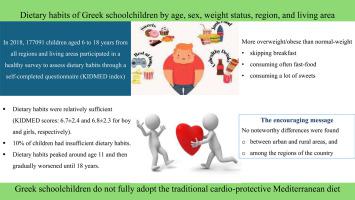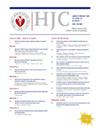按年龄、性别、体重状况、地区和居住区分列的 177 091 名希腊学童的饮食习惯。横断面研究
IF 3
3区 医学
Q2 CARDIAC & CARDIOVASCULAR SYSTEMS
引用次数: 0
摘要
本研究旨在调查来自全国各地区和生活区(农村/城市)的参与者从幼儿期到青春期的饮食习惯,并评估饮食习惯与男女肥胖之间的潜在关联。人口数据来自于对 177,091 名 6-18 岁儿童的代表性样本进行的横断面健康调查。饮食习惯通过自填问卷(儿童和青少年地中海饮食质量指数 [KIDMED])进行考量。训练有素的调查人员对人体测量数据进行了评估。男童和女童的 KIDMED 分数分别为 6.7 ± 2.4 和 6.8 ± 2.3,而饮食习惯不良者占研究总人数的近 10%。男女学生的饮食习惯在 11 岁左右达到高峰,然后逐渐恶化,直至青春期结束,男生的年趋势为-0.28 ± 0.02(p < 0.001),女生为-0.31 ± 0.03(p < 0.001)。与体重正常的儿童相比,超重/肥胖的学龄儿童在所有不健康饮食习惯(如不吃早餐、经常去快餐店和吃大量甜食)方面的比例都更高(所有 p 值均小于 0.001)。男女参与者的饮食习惯并没有因居住地区(即城市和农村)的不同而产生显著差异。此外,希腊各地区的 KIDMED 指数值也没有明显差异,其中阿提卡和克里特岛的男女生指数值最高。由于希腊学童并不完全采用传统的保护心血管的地中海饮食,因此提供一些建议(尤其是针对青少年)可能会有所帮助,从而降低未来对健康造成不良影响的风险。本文章由计算机程序翻译,如有差异,请以英文原文为准。


Dietary habits among 177,091 Greek schoolchildren by age, sex, weight status, region, and living area. A cross-sectional study
Background
This study aimed to investigate the dietary habits from early childhood to adolescence among participants from all regions of the country and living areas (rural/urban) and assess potential associations between dietary habits and obesity in both sexes.
Methods
Population data were derived from a cross-sectional health survey on a representative sample of 177,091 children aged 6–18 years. Dietary habits were considered via a self-completed questionnaire (Mediterranean diet quality index for children and adolescents [KIDMED]). Trained investigators assessed the anthropometric data.
Results
KIDMED scores were 6.7 ± 2.4 and 6.8 ± 2.3 for boys and girls, respectively, whereas a percentage of almost 10% of the total study population had insufficient dietary habits. Dietary habits peaked around age 11 years and then gradually worsened until the end of adolescence in both sexes, with an annual trend equal to −0.28 ± 0.02 (p < 0.001) for boys and −0.31 ± 0.03 (p < 0.001) for girls. Schoolchildren who are overweight/obese presented higher percentages in all unhealthy dietary habits (e.g., skipping breakfast, going often to a fast food restaurant, and consuming a lot of sweets) than children with a normal weight (all p-values < 0.001). Dietary habits did not noteworthy differ by area of living, that is, urban versus rural, of participants in both sexes. In addition, no noticeable differences in the values of the KIDMED index were found among all regions of Greece, with the highest values in Attica and Crete in both sexes.
Conclusions
Because Greek schoolchildren do not fully adopt the traditional cardio-protective Mediterranean diet, it could be helpful to provide certain recommendations, especially for adolescents, to decrease the risk for future adverse health consequences.
求助全文
通过发布文献求助,成功后即可免费获取论文全文。
去求助
来源期刊

Hellenic Journal of Cardiology
CARDIAC & CARDIOVASCULAR SYSTEMS-
CiteScore
4.90
自引率
7.30%
发文量
86
审稿时长
56 days
期刊介绍:
The Hellenic Journal of Cardiology (International Edition, ISSN 1109-9666) is the official journal of the Hellenic Society of Cardiology and aims to publish high-quality articles on all aspects of cardiovascular medicine. A primary goal is to publish in each issue a number of original articles related to clinical and basic research. Many of these will be accompanied by invited editorial comments.
Hot topics, such as molecular cardiology, and innovative cardiac imaging and electrophysiological mapping techniques, will appear frequently in the journal in the form of invited expert articles or special reports. The Editorial Committee also attaches great importance to subjects related to continuing medical education, the implementation of guidelines and cost effectiveness in cardiology.
 求助内容:
求助内容: 应助结果提醒方式:
应助结果提醒方式:


